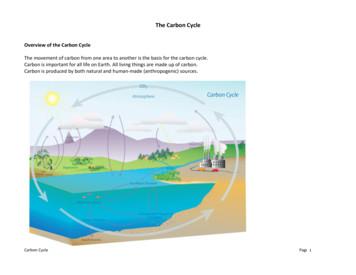How Big Are Your Carbon Feet? - Canadian Geographic
Presented by How Big Are Your Carbon Feet? Students will learn about the concept of carbon footprints and calculate their own. Learning outcomes By the end of this activity, students will: calculate their carbon footprint and explain its importance compare and contrast standards of living in Canada and those in developing countries (option 1) determine ways to decrease their carbon footprint (option 2) Complete ONE of the following options. You will only be able to submit work and get credit for one option. Calculate your carbon footprint and compare it with that of someone in the developing world Students will explore the concept of a carbon footprint. Students will then calculate their carbon footprint and that of someone in a developing country and compare the two. Calculate your carbon footprint and make changes to reduce it Students will explore the concept of a carbon footprint, calculate their yearly carbon footprint and create a picture informing others how to reduce or offset their carbon footprints. Important Please respect all school and governmental guidelines and restrictions surrounding COVID-19. Review the 2022 CEDC COVID-19 policy here. This challenge does NOT require students to participate in an in-person event. Classroom Energy Diet Challenge Energydiet.ca
How Big Are Your Carbon Feet? Calculate your carbon footprint and compare it with that of someone in the developing world Students will explore the concept of a carbon footprint. Students will then calculate their carbon footprint and that of someone in a developing country and compare the two. Materials Computers with Internet access for research, pens, pencils, paper. Proof to be submitted A Venn diagram highlighting similarities or student responses indicating a reflection comparing and contrasting their results. Activity Ask your students to define “carbon footprint” and “carbon offset” (see the Carbon Offset worksheet for the Get Growing challenge for help). Have students use one of the carbon calculator websites provided to calculate their yearly carbon footprint on their own. Have select students share their results with the class and discuss common trends in the class’s results. Next, explain to your students that they will be calculating the yearly carbon footprint of a person about their age living in a developing country and comparing that person’s footprint with their own. Have students research the lifestyle of a person living in a developing country and then estimate that person’s annual carbon footprint, record their results and comment on how the results are similar or different. In a Venn diagram or in paragraph form, have students compare and contrast the differences between the two footprints, describing how their lifestyles differ, what they learned, how they feel and what they can do to reduce their carbon footprint. Example Carbon Calculators Global Footprint Network Good planet foundation World Wildlife Fund Carbon Footprint calculator Zero Footprint Youth Calculator The Nature Conservancy Conservation International Teacher tip There are many carbon calculators you can use online. Before doing this activity, find a carbon calculator that will work with your entire class to ensure results are consistent. Classroom Energy Diet Challenge Energydiet.ca
How Big Are Your Carbon Feet? Calculate your carbon footprint and make changes to reduce it Students will explore the concept of a carbon footprint, calculate their yearly carbon footprint and create a picture informing others how to reduce or offset their carbon footprints. Materials Computers with Internet access for research, pens, pencils, paper, Footprint worksheet (attached). Proof to be submitted Photos of student carbon footprints. Activity Ask your students to define “carbon footprint” and “carbon offset” (see the Carbon Offset worksheet for the Get Growing challenge for help). Have students use one of the carbon calculator websites provided to calculate their yearly carbon footprint on their own. Have students share their results with the class and discuss common trends in the class’s results and what can be done to decrease their carbon footprint. Distribute one Footprint worksheet (attached) to each student and have students share ideas for how people can lower their carbon footprint. Encourage students to use coloured pencils to draw pictures and make their footprint as bright as possible. If possible, compile all the footprints together and create a display to share what your class learned. Example Carbon Calculators Global Footprint Network Good planet foundation World Wildlife Fund Carbon Footprint calculator Zero Footprint Youth Calculator The Nature Conservancy Conservation International Teacher tip There are many carbon calculators you can use online. Before doing this activity, find a carbon calculator that will work with your entire class to ensure results are consistent. Classroom Energy Diet Challenge Energydiet.ca
How Big Are Your Carbon Feet? Footprint worksheet Classroom Energy Diet Challenge Name Date Energydiet.ca
How Big Are Your Carbon Feet? Examples from previous years of how this challenge can be completed: Example 1 The Nobles Heart classroom coloured in their templates listing the ways they can reduce their carbon footprints. Example 2 The Climate Actionators completed their carbon footprint templates in different ways, showing how they can lower their footprints. Classroom Energy Diet Challenge Energydiet.ca
Calculate your carbon footprint and make changes to reduce it Students will explore the concept of a carbon footprint, calculate their yearly carbon footprint and create a picture informing others how to reduce or offset their carbon footprints. Learning outcomes By the end of this activity, students will: calculate their carbon footprint and .
L’ARÉ est également le point d’entrée en as de demande simultanée onsommation et prodution. Les coordonnées des ARÉ sont présentées dans le tableau ci-dessous : DR Clients Téléphone Adresse mail Île de France Est particuliers 09 69 32 18 33 are-essonne@enedis.fr professionnels 09 69 32 18 34 Île de France Ouest
Podcast Discusses Carbon Cycle, Carbon Storage. The “No-Till Farmer Influencers & Innovators” podcast released an episode discussing the carbon cycle and why it is more complicated than the common perception of carbon storage. In addition, the episode covered the role carbon cycling can play in today’s carbon credits program.
Carbon Cycle Page 1 The Carbon Cycle Overview of the Carbon Cycle The movement of carbon from one area to another is the basis for the carbon cycle. Carbon is important for all life on Earth. All living t
carbon footprint. The carbon footprint of a good or service is the total carbon dioxide (CO 2) and 1 Use of the Carbon Label logo, or other claims of conformance is restricted to those organisations that have achieved certification of their product’s carbon footprint by Carbon Trust Certi
Chapter 2-3 Carbon Compounds. A. Organic compounds- originally thought to be compounds produced by living organism, now it refers to compounds containing carbon. 6 C Carbon 12.011. a. Carbon atoms have 4 valence electrons 1. The carbon atom is unique and carbon compounds are
- Alkanes are hydrocarbons with all carbon-carbon single bonds - Alkenes are hydrocarbons with a carbon-carbon double bond - Alkynes are hydrocarbons with a carbon-carbon triple bond - Cycloalkanes are alkanes in which all or some of the carbon atoms are arranged in a ring - Alkanes have the general formula of C n H 2n 2
The Rise of Big Data Options 25 Beyond Hadoop 27 With Choice Come Decisions 28 ftoc 23 October 2012; 12:36:54 v. . Gauging Success 35 Chapter 5 Big Data Sources.37 Hunting for Data 38 Setting the Goal 39 Big Data Sources Growing 40 Diving Deeper into Big Data Sources 42 A Wealth of Public Information 43 Getting Started with Big Data .
Certification Standard Animal Nutrition – V5 for January 2020 P a g e 7 81 Daily ration: Average total quantity of feedingstuffs, calculated on a moisture content of 12 %, required daily by an animal of a given species, age category and yield, to satisfy all its needs (Regulation 1831/2003).























